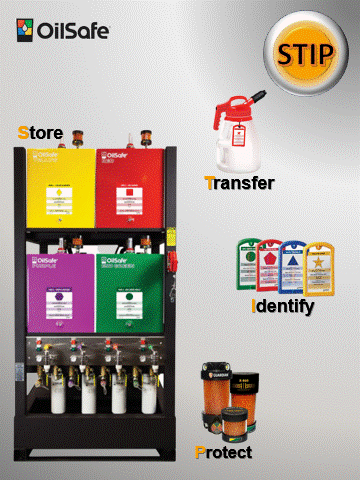What does STIP stand for? | Lubripedia
STIP stands for Store, Transfer, Identify, Protect.
It is a framework used in lubrication reliability to ensure that lubricants are handled, stored, and applied correctly throughout their life cycle.
Following STIP principles helps prevent contamination, misapplication, and degradation of lubricants – leading to improved equipment performance and longer service life.

1. Store – keep lubricants clean and dry
Proper storage is the foundation of any lubrication reliability programme.
Lubricants should always be stored in a clean, dry, and temperature-controlled environment to prevent contamination from dirt, moisture, or temperature fluctuations.
Key practices include:
- Using a dedicated lube room or storage area.
- Keeping containers sealed and labelled.
- Storing drums horizontally or under cover to avoid water ingress.
- Regularly inspecting containers for leaks or damage.
By storing lubricants correctly, you maintain their quality and extend their usable life.
2. Transfer – move lubricants safely and cleanly
The way lubricants are transferred from storage to application has a major effect on cleanliness.
Using dedicated, sealed transfer containers (such as OilSafe® units) prevents cross-contamination and exposure to airborne particles.
Best practices include:
- Using colour-coded and labelled containers for each lubricant type.
- Avoiding open funnels, buckets, or unsealed transfer tools.
- Using filtration or pumping systems during transfer to maintain fluid cleanliness.
Clean transfer ensures that lubricants reach the equipment in the same condition as when received.
3. Identify – eliminate confusion and misapplication
Identification prevents the accidental mixing of incompatible lubricants.
Each lubricant should have a clear, unique label that follows it from storage to the point of use.
Good identification systems include:
- Colour-coded labels, tags, and lids.
- Clearly marked equipment fill points.
- Lubrication charts showing product names, types, and specifications.
Correct identification ensures technicians always use the right lubricant in the right place.
4. Protect – safeguard lubricants from contamination
Protection focuses on preventing external contaminants from entering lubrication systems.
This includes dust, moisture, and particles that can accelerate wear and failure.
Protection methods include:
- Installing desiccant breathers or check-valve breathers on storage containers and machines.
- Using filters and seals to maintain fluid cleanliness.
- Keeping containers and equipment closed when not in use.
Effective protection helps maintain lubricant integrity, improves reliability, and reduces maintenance costs.
Why STIP matters:
Implementing STIP across all lubrication processes leads to:
- Cleaner, longer-lasting lubricants.
- Fewer equipment failures and breakdowns.
- Improved reliability and uptime.
- Lower maintenance and replacement costs.
In short, STIP provides a structured approach to contamination control and lubrication excellence.
